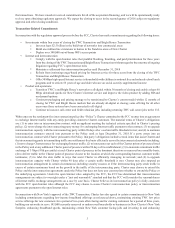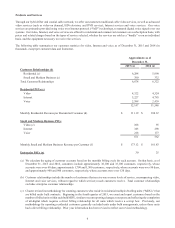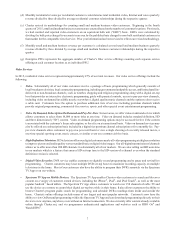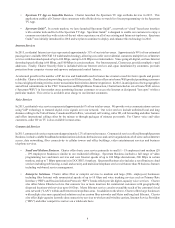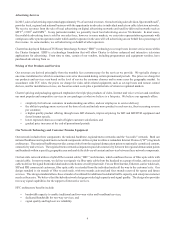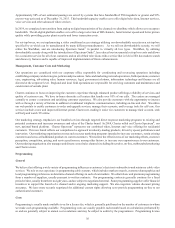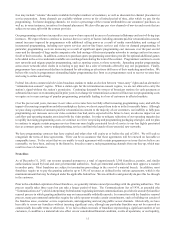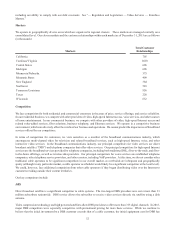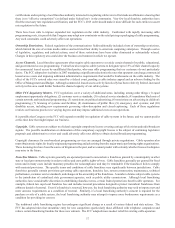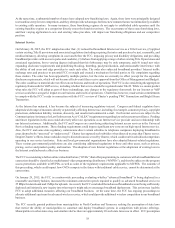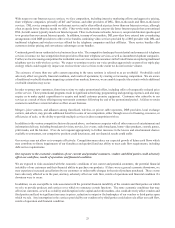Charter 2015 Annual Report Download - page 28
Download and view the complete annual report
Please find page 28 of the 2015 Charter annual report below. You can navigate through the pages in the report by either clicking on the pages listed below, or by using the keyword search tool below to find specific information within the annual report.13
decreased substantially, as the DBS providers have aggressively marketed offers to new customers of incentives for discounted
or free equipment, installation, and multiple units. DBS providers are able to offer service nationwide and are able to establish a
national image and branding with standardized offerings, which together with their ability to avoid franchise fees of up to 5% of
revenues and property tax, leads to greater efficiencies and lower costs in the lower tiers of service. We believe that cable-delivered
video on demand and subscription video on demand services, which include HD programming, are superior to DBS service,
because cable headends can provide communication to deliver many titles which customers can access and control independently,
whereas DBS technology can only make available a much smaller number of titles with DVR-like customer control. DBS providers
have also made attempts at deployment of Internet access services via satellite, but those services have been technically constrained
and of limited appeal.
Telephone Companies and Utilities
Incumbent telephone companies, including AT&T Inc. (“AT&T”) and Verizon Communications, Inc. (“Verizon”), offer video and
other services in competition with us, and we expect they will increasingly do so in the future. These companies are able to offer
and provide two-way video, data and digital voice services that are similar to ours in various portions of their networks. In the
case of Verizon, its high-speed data services (fiber optic service (“FiOS”)) offer speeds as high as or higher than ours. In addition,
these companies continue to offer their traditional telephone services, as well as service bundles that include wireless voice services
provided by affiliated companies. Based on internal estimates, we believe that AT&T (excluding DirecTV) and Verizon are offering
video services in areas serving approximately 35% and 4%, respectively, of our estimated residential passings and we have
experienced customer losses in these areas. AT&T and Verizon have also launched campaigns to capture more of the MDU market.
When AT&T or Verizon have introduced or expanded their offering of video products in our market areas, we have seen a decrease
in our video revenue as AT&T and Verizon typically roll out aggressive marketing and discounting campaigns to launch their
products. Moreover, in July 2015, AT&T completed its acquisition of DirecTV, the nation’s largest DBS provider. This transaction
created an even larger competitor for Charter’s video services that has the ability to expand its video service offerings to include
bundled wireless offerings.
In addition to incumbent telephone companies obtaining video franchises or alternative video authorizations, they have been
successful through various means in reducing or streamlining the video franchising requirements applicable to them. They have
had success at the federal and state level in securing FCC rulings and statewide video franchise laws that facilitate telephone
company entry into the video marketplace. Because telephone companies have been successful in avoiding or reducing franchise
and other regulatory requirements that remain applicable to cable operators like us, their competitive posture has been enhanced
in some areas. The large scale entry of incumbent telephone companies as direct competitors in the video marketplace has adversely
affected the profitability and valuation of our cable systems.
Most telephone companies, including AT&T and Verizon, which already have plant, an existing customer base, and other operational
functions in place (such as billing and service personnel), offer Internet access via traditional DSL service. DSL service allows
Internet access to subscribers at data transmission speeds greater than those formerly available over conventional telephone lines.
We believe DSL service is an alternative to our high-speed Internet service and is often offered at prices lower than our Internet
services, although typically at speeds lower than the speeds we offer. DSL providers may currently be in a better position to offer
voice and data services to businesses since their networks tend to be more extensive in commercial areas. We expect DSL to
remain a significant competitor to our high-speed Internet services.
Many large incumbent telephone companies also provide fiber-to-the-node or fiber-to-the-home services in select areas of their
footprints. Fiber-to-the-node networks can provide faster Internet speeds than conventional DSL, but still cannot typically match
our Internet speeds. Our primary fiber-to-the-node competitor is AT&T's U-verse. The competition from AT&T U-verse is expected
to intensify over time as AT&T completed an expansion in 2014 based on plans announced in late 2012 and entered into additional
expansion commitments in connection with its acquisition of DirecTV. Fiber-to-the-home networks, however, can provide Internet
speeds equal to or greater than Charter's current Internet speeds. Verizon's FiOS is the primary fiber-to-the-home competitor,
although AT&T has also begun fiber-to-the home builds as well.
Our voice service competes directly with the voice services of incumbent telephone companies and other carriers, including
Internet-based VoIP providers, for both residential and commercial voice service customers. Because we offer voice services, we
are subject to considerable competition from such companies and other telecommunications providers, including wireless providers,
with an increasing number of consumers choosing wireless over wired telephone services. The telecommunications and voice
services industry is highly competitive and includes competitors with greater financial and personnel resources, strong brand name
recognition, and long-standing relationships with regulatory authorities and customers. Moreover, mergers, joint ventures and
alliances among our competitors have resulted in providers capable of offering video, Internet, and voice services in direct
competition with us.


